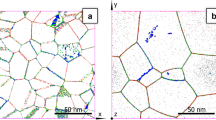Abstract
The properties of self di-interstitials—clusters formed by two self-interstitial atoms—in fcc copper crystal have been studied by the molecular statics and molecular dynamics methods. The formation energy (5.26 eV) and binding energy (0.83 eV) of the most energetically favorable configuration of a di-interstitial have been determined. The temperature dependences of the di-interstitial diffusion characteristics (diffusivity, the tracer correlation factor, the mean distance traveled between changes in migration direction, the frequency of migration direction changes, etc.) have been calculated for the temperature range of 300–1000 K; the temperature dependence of the di-interstitial dissociation lifetime has been calculated for the temperature range of 900–1100 K. Analytical dependences describing the calculated data have been proposed. The activation energy of di-interstitials dissociation is determined: 0.88 eV. For typical values of radiation defect sink strengths in radiation resistant materials (1015–1016 m–2), temperature limits below which the overwhelming amount of di-interstitials are absorbed by the sinks before their dissociation are determined: 630–740 K.






Similar content being viewed by others
REFERENCES
M. Merola, D. Loesser, A. Martin, P. Chappuis, R. Mitteau, V. Komarov, R. A. Pitts, S. Gicquel, V. Barabash, L. Giancarli, J. Palmer, M. Nakahira, A. Loarte, D. Campbell, R. Eaton, et al., Fusion Eng. Des. 85, 2312 (2010). https://doi.org/10.1016/j.fusengdes.2010.09.013
P. Norajitra, R. Giniyatulin, T. Ihli, G. Janeschitz, W. Krauss, R. Kruessmann, V. Kuznetsov, I. Mazul, V. Widak, I. Ovchinnikov, R. Ruprecht, and B. Zeep, Fusion Eng. Des. 82, 2740 (2007). https://doi.org/10.1016/j.fusengdes.2007.05.027
Yu. S. Shpanskiy and the DEMO-FNS Project Team, Nucl. Fusion 59, 076014 (2019). https://doi.org/10.1088/1741-4326/ab14a8
D. Stork, P. Agostini, J. L. Boutard, D. Buckthorpe, E. Diegele, S. L. Dudarev, C. English, G. Federici, M. R. Gilbert, S. Gonzalez, A. Ibarra, Ch. Linsmeier, A. Li Puma, G. Marbach, P. F. Morris, et al., J. Nucl. Mater. 455, 277 (2014). https://doi.org/10.1016/j.jnucmat.2014.06.014
Y. Mishin, M. J. Mehl, D. A. Papaconstantopoulos, A. F. Voter, and J. D. Kress, Phys. Rev. B 63, 224106 (2001). https://doi.org/10.1103/PhysRevB.63.224106
M. S. Daw and M. I. Baskes, Phys. Rev. B 29, 6443 (1984). https://doi.org/10.1103/PhysRevB.29.6443
M. I. Mendelev, M. J. Kramer, C. A. Becker, and M. Asta, Philos. Mag. 88, 1723 (2008). https://doi.org/10.1080/14786430802206482
M. I. Mendelev and A. H. King, Philos. Mag. 93, 1268 (2013). https://doi.org/10.1080/14786435.2012.747012
A. B. Sivak, D. N. Demidov, and P. A. Sivak, Vopr. At. Nauki Tekh., Ser. Termoyad. Sintez 44 (1), 106 (2021). https://doi.org/10.21517/0202-3822-2021-44-1-106-118
D. J. Bacon, Yu. N. Osetsky, R. Stoller, and R. E. Voskoboinikov, J. Nucl. Mater. 323, 152 (2003). https://doi.org/10.1016/j.jnucmat.2003.08.002
S. Miyashiro, S. Fujita, and T. Okita, J. Nucl. Mater. 415, 1 (2011). https://doi.org/10.1016/j.jnucmat.2011.03.056
Y. Yang, T. Okita, M. Itakura, T. Kawabata, and K. Suzuki, Nucl. Mater. Energy 9, 587 (2016). https://doi.org/10.1016/j.nme.2016.07.008
M. M. Li and S. J. Zinkle, in Comprehensive Nuclear Materials, 2nd ed. (2020), p. 693. https://doi.org/10.1016/B978-0-12-803581-8.11618-2
I. S. Batra, G. K. Dey, U. D. Kulkarni, and S. Banerjee, J. Nucl. Mater. 299, 91 (2001). https://doi.org/10.1016/S0022-3115(01)00691-2
L. Verlet, Phys. Rev. 159, 98 (1967). https://doi.org/10.1103/PhysRev.159.98
M. W. Guinan, R. N. Stuart, and R. J. Borg, Phys. Rev. B 15, 699 (1977). https://doi.org/10.1103/PhysRevB.15.699
Yu. N. Osetsky, Def. Dif. Forum 188–190, 71 (2001). https://doi.org/10.4028/www.scientific.net/DDF.188-190.71
H. L. Heinisch, B. N. Singh, and S. I. Golubov, J. Comput. Aided Mater. Des. 6, 277 (1999). https://doi.org/10.1023/A:1008777901639
L. Malerba, C. S. Becquart, and C. Domain, J. Nucl. Mater. 360, 159 (2007). https://doi.org/10.1016/j.jnucmat.2006.10.002
A. B. Sivak, D. N. Demidov, and P. A. Sivak, PAS and T/TF 44, 148 (2021). https://doi.org/10.21517/0202-3822-2021-44-2-148-157
D. N. Demidov, A. B. Sivak, and P. A. Sivak, Vopr. At. Nauki Tekh., Ser. Termoyad. Sintez 42 (2), 99 (2019). https://doi.org/10.21517/0202-3822-2019-42-2-99-107
J. R. Manning, Diffusion Kinetics for Atoms in Crystals (D. Van Nostrand, Toronto, 1968).
R. A. Johnson, Phys. Rev. 145, 423 (1966). https://doi.org/10.1103/physrev.145.423
P. Benoist, J.-L. Bocquet, and P. Lafore, Acta Metall. 25, 265 (1977). https://doi.org/10.1016/0001-6160(77)90145-6
S. J. Zinkle and L. L. Snead, Ann. Rev. Mat. Res. 44, 241 (2014). https://doi.org/10.1146/annurev-matsci-070813-113627
Funding
This work was supported by ongoing institutional funding. No additional grants to carry out or direct this particular research were obtained.
Author information
Authors and Affiliations
Corresponding authors
Ethics declarations
The authors of this work declare that they have no conflicts of interest.
Additional information
Translated by G. Dedkov
Publisher’s Note.
Pleiades Publishing remains neutral with regard to jurisdictional claims in published maps and institutional affiliations.
Rights and permissions
About this article
Cite this article
Demidov, D.N., Sivak, A.B. Properties of Self-di-Interstitials in Copper: Molecular Dynamics Study. Phys. Atom. Nuclei 86 (Suppl 1), S91–S98 (2023). https://doi.org/10.1134/S106377882313001X
Received:
Revised:
Accepted:
Published:
Issue Date:
DOI: https://doi.org/10.1134/S106377882313001X



